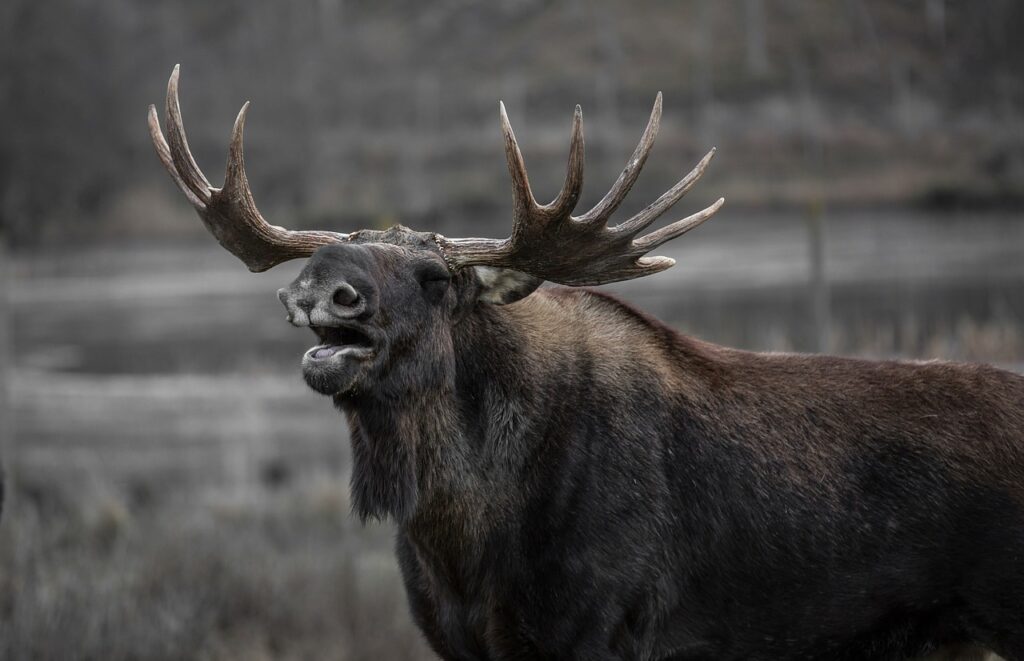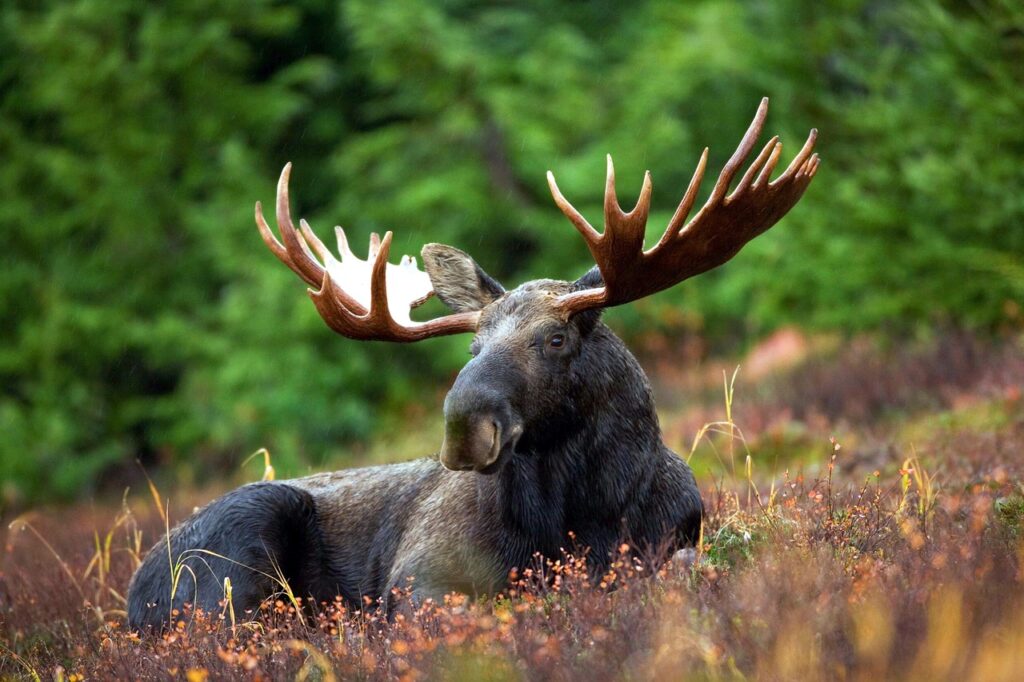The moose and stag share similar physical features because both belong to the Cervidae family, also known as the Deer family. These species are so closely related that it is often challenging to tell them apart, especially when viewing them from afar. By identifying these 11 main differences below, you will be able to scrutinize and easily distinguish a moose from a stag.
Differences Between a Moose and a Stag
Size
A stag is a basic term or name given to an adult male species of the Cervidae family. It is not a universal term, and its use may vary from one region to another, but it generally refers to a large adult male Cervidae.

Although a moose is also part of the Cervidae, the adult males of this species are called bull, thus, the term Bull Moose. Moose is the largest species of the Cervidae, and this is one of the main differences that can help you identify a stag from a moose. The stags are large adult male deers, but when compared to a moose, the latter is still traditionally larger.

Color
A stag is an adult male deer, particularly of the red deer species. The term ‘stag’ impreciseness brings forth the variability of stag species and colors that ranges from white to dark and reddish-brown. Moose, however, only refers to a particular species that have a darker coat color that can range from chocolate brown to black. These color differences are among the features that can help you tell a moose from a stag.
Neck
If you take a close look at a stag and a moose, you will notice right away a striking feature that differs one from the other. Moose have a dewlap, better known as a bell, an extra fold of skin hanging loosely below its neck. This is a prominent feature missing on any stags that only features a thick and long fur without any fold of extra skin below its neck.
Nose
The nose is a distinct feature that can help you differentiate a moose from a deer. Compared to all other Cervidae species, moose have developed a much longer and more rounded nose. The distinct nose structure helps moose in discharging body heat when running to escape from predators and smell predators from afar. Stags, however, have shorter and pointed noses that are visibly black or darker than their fur.
Antlers
Although both moose and stag have antlers as an extension of their skull, their structure is not the same when you compare one from the other. Moose have a flatter and broader antlers which is something that distinguishes them from the other Cervidae species. Stags have antlers that are relatively smaller in diameter and ranges from 12 to 15 points or branches. Most hunters collecting antlers typically prefer those from a stag to those from a moose primarily out of aesthetics. Stag antlers have a better shape that makes them perfect to be hanged on a wall.
Weight
When it comes to body mass, a moose is relatively heavier than a stag. The average weight is 160 to 240 kilograms, while the average weight of a moose is 385 to 534 kilograms for males and 270 to 362 kilograms for females. Moose are huge, and their size and big appetite are the contributing factors to their heavier weight.
Agility
Although moose are surprisingly agile, they are still huge and heavy compared to a stag or any other species from the Deer family. The smaller and lighter stags can move quicker and easier than moose, making them more agile than the latter.
Tracks
The marks that these animals leave are also among their differentiating factors. Stags have a more elongated tooth-shaped track that appears as symmetrical halves. Moose, however, have much deeper and heart-shaped hooves. The pointed tip of the heart-shaped hooves determines the direction where the moose is heading to.
Behavior
Moose prefers to be alone and far from the herd, while stag prefers to be in the company of large herds. Except for female moose that need to tend their young, these deer species are generally solitary that they even remove themselves from their partner after mating. This is in contrast to stags that are as social as they are nomadic. Stags prefer to travel in a group, especially during summer when they seek the abundance of food from a forest.
Habitat
Both moose and stags thrive in forested areas where they can enjoy food in abundance. While stags adapt even in desert regions, moose have to be near streams or any body of water to survive the heat. Moose are larger, heavier, and they have thicker furs that limit them to colder places. It is the reason why more and more moose are migrating up north because they need a colder climate to live comfortably.
Animal Sounds
The animal sounds that these species make are significantly different from one to the other. Moose are known for their bark sound that resembles that of a bugle instrument. Stags, however, can produce a more diverse range of animal sounds. Depending on the stag species, the stag sound can resemble a dog’s bark or a creepy high-pitched sound that’s similar to the vibration of a whistle.
Diet
Moose and stags are both herbivores that share almost the same role in the food chain. However, there is one significant difference in the diet of these two different species of Cervidae. These animals are both excellent swimmers, and they often search for food in bodies of water, but only the moose can feed underwater.
Questions and Answers
What is a Stag-Moose?
Contrary to what most people believe, a Stag-Moose is not a moose but a different deer species that resembles the physical feature. It is an extinct species native to North America, and its existence can be dated as far back as 10,000 to 2 million years. The Stag-Moose features a palmate antler similar to a moose and a nose resembling a stag.
Female moose can breed with a stag, and together they can produce a healthy hybrid. Hybridization does not only occur in the wild, for there are some farm breeders who specifically interbreed these different species to acquire an improved quality of meat.
Why Aren’t Moose and Stag Widely Domesticated?
The wild nature of these deer species is the primary reason why they can not be widely domesticated. They are extremely difficult to tame and can be highly dangerous when provoked. On the rare occasions wherein either of these animals is kept in captivity on a farm, they will need to be confined inside a very sturdy fence. This means that keeping these species can be a lot expensive compared to regular cows or horses.
Are Moose and Stag Dangerous?
This Cervidae species will not always be submissive to humans. They can be very dangerous considering that they have strong antlers and hooves that they can use to attack and protect themselves.
How can I tell if the moose or stag is preparing for an attack?
To identify if the moose or stag is preparing for an attack, scrutinize its posture and ear. If it lowers its head and lays back its ears, that could indicate that you have provoked the animal. If a deer starts stomping, you have to wave a large cloth in its direction because it shows clear signs that it will attack. A large cloth can make you appear bigger, which will make the animal hesitate in attacking. However, moose and stags are more massive, which means that you will need a different approach. Once you see a moose or stag stomping, slowly move away from the animal and raise your arms as if you’re showing signs of surrender. The animal will most likely understand this gesture and will not continue to attack. But if the animal continues to be aggressive, running would be the best move so that it can not reach you and cause harm using its antler and hooves.
What are the ultimate predators of moose and stag?
Aside from wolves, coyotes, mountain lions, and bears, humans are also among the predators of these species. Humans are the ultimate predators of moose and stag. They are being hunted by people both for sport and meat. Antlers that hunters acquire from hunting these animals are being preserved to adorn walls, especially in rustic vacation homes. These antlers are kept to serve as a trophy for killing such a strong and dangerous beast. Humans are also hunting moose and stag for their extremely nutritious meat called Venison. It is a term referring to meats acquired from large game animals, especially from the Deer family.

